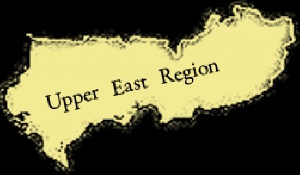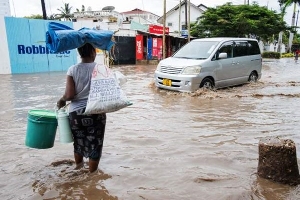- Home - News
- TWI News | TV
- Polls
- Year In Review
- News Archive
- Crime & Punishment
- Politics
- Regional
- Editorial
- Health
- Ghanaians Abroad
- Tabloid
- Africa
- Religion
- Election 2020
- Coronavirus
- News Videos | TV
- Photo Archives
- News Headlines
- Press Release
Opinions of Sunday, 26 February 2017
Columnist: Akapule, Samuel Adadi
The Upper East Region, the hub of investment opportunities
By Samuel Adadi Akapule
It has been generally concluded by some school of thought that the Upper East Region is one of the poorest among the ten regions of the country. But this stands to be contested. As a native of the area and a professional Journalist who has been working there for almost eleven years, I disagree with those who have branded the region one of the poorest in the country.
Apart from the fact that it is endowed with a lot of potential, it is also well noted for its high calibre of human resource. Perhaps what is lacking is the needed support to help unlock the potentials in the region to help accelerate the development of the area and the present Government’s policy of one District one factory and one dam one village has come at the right time.
Historically Background of the Region
Historically from 1902 the old Northern Territory was a British Protectorate until the 1960s when it was separated into Northern and Upper Region. The Upper Region was later divided into Upper East and Upper West in 1983 during the Provisional National Defense Council (PNDC) Regime.
Also, the Region is located in the north-eastern corner of the country and is bordered to the north by Burkina Faso; the east by the Republic of Togo, the west by Sissala District in Upper West and the south by West Mamprusi in Northern Region. The land is relatively flat with a few hills to the east and southeast. The total land area is about 8,842 sq km, which translates into 2.7 per cent of the total land area of the country.
Agricultural Potential
Agriculture is one of the greatest potential in the Region. One of them being the large-scale production of rice in the now onchocerciasis (river blindness) free zone which encompasses the Fumbisi and Gbedembillisi areas in the Builsa South and Builsa North Districts. In fact agricultural researchers have proved that the Fumbisi rice valley when given special attention could produce to feed the whole nation and even export for foreign exchange for the country. “This area has vast lands and suitable soil, which if properly exploited, will give high yields of rice for local consumption and export”, the former Upper East Regional Director of Ministry of Food and Agriculture, Alhaji Ahmed Musbawo , once told this Writer.
Besides, the region has a great potential in the area of cash crop production and fish farming. This is due to the existence of many irrigation sites in the area. In addition to the Vea and Tono Irrigation Dams, there are more than 220 dams and dugouts in the Region, which have lands suitable for crops such as onion, tomatoes and pepper cultivation. Livestock rearing is also a common agricultural activity among the people in the Region. It has about 18 per cent of cattle and nine per cent of the small ruminants in the country. It supplies 50,000 cattle, 40,000 sheep and 40,000 goats to the Southern Sector of the country annually. Poultry is mostly local birds and domesticated guinea fowls. Most of these livestock are kept on an unimproved scavenging regime, although some supplementary feeding is done especially during the dry season. Potential investors therefore have a lot to gain since the Region has a great potential for commercial livestock and poultry rearing.
Mining Potential of the Region
In spite of the relatively developed nature of the mining and quarrying industry, the industry has potential for further development. Potential investors, therefore stand to gain from the sector, considering the 'ready-market' available and the existence of large outcrops of granite especially in the Kassean-Nankana West District and its environs. Feasibility studies have also shown that there are large deposits of manganese in areas between Nangodi and Duusi and the north-west of Pwalugu all in the Talensi and Nabdam Districts of the Region. No exploitation of this mineral has been carried out yet. Investors could, therefore, take advantage of this. There is a large prospect in the Region for investors wishing to go into brick and tile production because of the availability of large deposits of clay of various types. Areas with clay deposits include Gambibgo, Zanlerigu, Yikini and Kalbeo. Burnt bricks produced from clay deposits can be used in the development of cheaper housing, which is in line with the Government's policy of developing the rural areas using local resources. Thus, this should be an incentive to potential investors.
Tourists' Attraction
The Region is not left out when it comes to sites and scenes of tourist interest. They are numerous tourist attractions in the Region, notable among them are the Paga Crocodile Pond; the Bolgatanga Museum which houses objects of historical importance of the Region and the Kulungugu Bomb Site, where an attempt was made on the life of Ghana's First President, Osagyefo Dr Kwame Nkrumah. Others are the three point elevation at Pusiga, where the tip of the boundary demarcation between the three sister countries of Ghana, Burkina Faso and Togo converge, the Tongo Hills and the Navrongo Cathedral with its elegant constructional and decorated designs which portray the beauty in the art of the people.
The archaeological treasures of the basin of the River Sissili, the Whistling and Drumming Rocks at Tongo in the Talensi-Nabdam District and Chiana in the Kassena Nanakana West; the Awologo-Tango at Bongo; Wall decoration at Tilli and Kandiga; famous shrines and caves also constitute places of culture and tourists' attractions.
Festivals such as the Feok, Samapiid, Azambene and Gologo, among others are celebrated by the people of Builsa; Bawku Municipal; Bongo; Bolgatanga-Tongo and Kassena-Nankana. These draw a lot of tourists to the Region. Sandema in the Builsa District is famous as the site where Builsa warriors captured and killed the slave raiders, Samori and Babatu, to mark the end of the slave trade in the Northern part of Ghana. Despite these potentials, the Region lacks the necessary infrastructure and other services to support and market it. The Region would require massive investment to develop these potentials and to create jobs. As a known fact, small-scale industries constitute the most important industries in the Region. An investment in this sector especially in basketry, leather works and smock weaving would expand production to meet the growing demand for these crafts outside the country. Markets abound for these crafts in countries such as Britain, Germany and the USA. Already, these constitute a large proportion of non-traditional exports.
Existing Industries
There are three industries including cotton ginnery at Pusu-Namongo (near Bolgatanga), Tomato Canning Factory at Pwalugu, which are all not fully functioning, the defunct Meat Processing Factory (GIHOC) at Zuarungu and the defunct Rice Mills at Bolgatanga.
The two forms of extractive activities in the Region are mining and quarrying. While the quarrying industry is being actively exploited the same cannot be said about the mining industry. There are two commercial quarries in the Region namely, the Upper Quarry Limited located at Pwalugu on the Bolgatanga-Tamale road and the Granites and Marbles Company Limited located in Tongo. The former produces granite chippings for the construction industry while the latter cuts rocks in the form of bricks for export. These are polished and used in the cladding of commercial buildings and monuments.
The gold mining industry is not well developed in the Region. Gold was mined during the Colonial Administration around Nangodi, about 24 kms from Bolgatanga on the Bolgatanga-Bawku road. Mining activities, however, stopped in 1930. Lately, small-scale gold mining, popularly known as "galamsey" (gather and sell) or "alakpiri" has become rampant in the areas of Tongo, Sheaga, Duusi, Pelengu and other small villages. This gives an indication of the existence of gold deposits in viable quantities.
Crafts, varied as they are, include, pottery, basketry and smock weaving which is done at areas like Namoo, Zokko, Navrongo and Paga. Leatherworks are carried out at areas around Bolgatanga and the surrounding villages. Straw works are also concentrated around Bolgatanga. One distinct feature of these cottage industries is that they are basically labour intensive and rely mostly on traditional talent and skills.
In spite of all these potentials in the Region, it is still viewed as one of the most deprived areas where its people live in misery because they have not been able to exploit or showcase these potentials to the outside world.
To conclude, the question one may pause to ask is that how can a region that is endowed with such abundant potentials be tagged as one the poorest region in the country. What is lacking is the ability and the lack of political commitment from stakeholders particularly government to help tap these potentials for the acceleration of the development of the area.
There is no doubt that marketing the potentials of the Region to the outside world would help other local and foreign partners to help tap the full potentials of the region to create employment and help to reduce poverty in the area. This would further help stop the youth in the area from trouping to Southern Ghana in such of non-existent jobs and returning home with infectious diseases.
The present government must cease the opportunity to help turn the fortunes of the region around. They stand to leave a good legacy if they succeed in doing so. The Members of Parliament and traditional authorities from the area including all the Civil Society Organisations and the citizens must forge together to help tap the rich potentials of the region.
samuelakapule@yahoo.com











